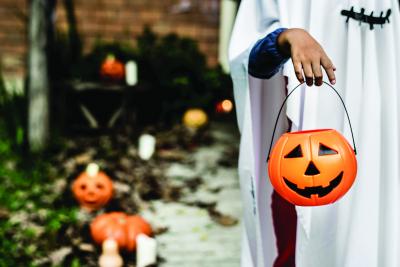October 2019: Halloween & Trick-or-Treating Safety
Trick-or-Treating Safety
Navigating the neighborhood while trick-or-treating, or to visit haunted houses is a special Halloween tradition. But at the same time, we want parents and children to enjoy a fun and safe Halloween.
- A parent or responsible adult should always accompany young children on their neighborhood rounds.
- Have flashlights with fresh batteries for all children and their escorts.
- If your older children are going alone, plan and review the route that is acceptable to you. Agree on a specific time when they should return home.
- Only go to homes with a porch light on and never enter a home or car for a treat.
- Law enforcement authorities should be notified immediately of any suspicious or unlawful activity.
Because pedestrian injuries are the most common on Halloween, remind Trick-or-Treaters:
- Stay in a group and communicate where they will be going. Carry a cellphone for quick communication.
- Remember reflective tape for costumes and trick-or-treat bags.
- Remain on well-lit streets and always use the sidewalk. If no sidewalk is available, walk at the far edge of the roadway facing traffic.
- Only cross the street as a group in established crosswalks. Never cross between parked cars or out of driveways.
- Don’t assume the right of way. Motorists may have trouble seeing Trick-or-Treaters.
Costume Safety
- Plan costumes that are bright and reflective. Make sure that shoes fit well and that costumes are short enough to prevent tripping or entanglement.
- Because masks can limit or block eyesight, consider non-toxic makeup and decorative hats as safer alternatives. Hats should fit properly so they don’t slide over eyes.
- When shopping for costumes, wigs, and accessories, look for and purchase those with a label clearly indicating they are flame resistant.
- If a sword, cane, or stick is a part of your child’s costume, make sure it is not sharp or long. A child may be easily hurt by these accessories if he stumbles or trips.
- Do not use decorative contact lenses. While the packaging on decorative lenses will often make claims such as “one size fits all,” or “no need to see an eye specialist,” using decorative contact lenses without a prescription is both dangerous and illegal. This can cause pain, inflammation, and serious eye disorders and infections, which may lead to permanent vision loss.
Treat Checking
- Wait until children are home to sort and check treats. Though tampering is rare, a responsible adult should closely examine all treats and throw away any spoiled, unwrapped or suspicious items.
- If your child has a food allergy, read the ingredient label on treats. Many popular Halloween candies contain some of the most common allergens, such as peanuts or tree nuts, milk, egg, soy or wheat.
“Unhaunting” Your Home
- Remove from the porch and front yard anything a child could trip over such as garden hoses, toys, bikes and lawn decor.
- Parents should check outdoor lights and replace burned-out bulbs.
- Wet leaves should be swept from sidewalks and steps.
- Restrain pets so they do not inadvertently jump on or bite a trick-or-treater or run away.
Pumpkin Carving
- Small children should never carve pumpkins. Children can draw a face with markers. Then parents can do the cutting.
- Consider using a flashlight or glow stick instead of a candle to light your pumpkin. If you do use a candle, a votive candle is safest.
- Candlelit pumpkins should be placed on a sturdy table, away from curtains and other flammable objects, and not on a porch or any path where visitors may pass close by. They should never be left unattended.
Pet Safety
Halloween can be the spookiest night of the year, but keeping your pets safe doesn’t have to be tricky. The ASPCA recommends taking these simple, common-sense precautions to keep your pet happy and healthy all the way to November 1.
- Stash the Treats. Several popular Halloween treats are toxic to pets. Chocolate in all forms—especially dark or baking chocolate— can be very dangerous, and sugar-free candies containing the sugar substitute xylitol can cause serious problems in pets.
- Watch the Decorations and Keep Wires Out of Reach. While a carved jack-o-lantern certainly is festive, pets can easily knock over a lit pumpkin and start a fire.
- Be Careful with Costumes. For some pets, wearing a costume may cause undue stress. The ASPCA recommends that you don’t put your dog or cat in a costume unless you know he or she loves it. If you do dress up your pet for Halloween, make sure the costume does not limit his or her movement, sight or ability to breathe, bark or meow.
- Keep Pets Calm and Easily Identifiable. Halloween brings a flurry of activity with visitors arriving at the door, and too many strangers can often be scary and stressful for pets. All but the most social dogs and cats should be kept in a separate room away from the front door during peak trick-or-treating hours. While opening the door for guests, be sure that your dog or cat doesn’t dart outside. And always make sure your pet is wearing proper identification—if for any reason he or she does escape, a collar with ID tags and/or a microchip can be a lifesaver for a lost pet.
To view a printable brochure of these helpful tips, download our Halloween Safety Brochure.

